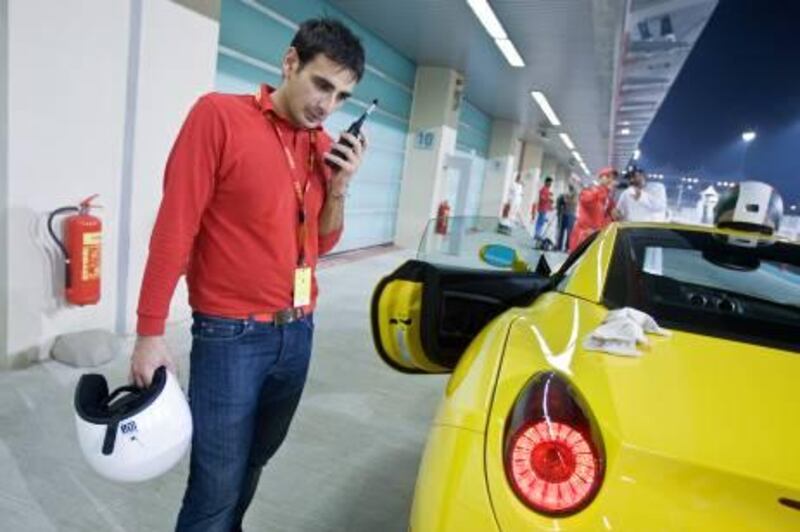Hard to believe, but there is someone out there who loves their job more than we do here at Motoring.
Raffaele De Simone is a slim, quiet Italian; a very youthful 30 years old. And instead of spending his days behind a computer in some grey-walled office, De Simone sits in a slightly more exciting workplace - he's a test driver for one of the most fabled car makers in the world, Ferrari. It's been De Simone's job for the past 10 years to help develop the cars that come out of the Maranello factory, and he was at Yas Marina last week offering driving tips to the media and ultimately getting behind the wheel of a Ferrari California to show us all how bad we really are at driving fast. In his lyrical Italian accent, De Simone talks about his career with Ferrari and his love of the cars that he helps create.
How do you become a Ferrari test driver? For the former race car driver, it was part talent and part fate. "On occasion of Ferrari racing days, an event where there was a Challenge championship with a [Ferrari] 360, I met Dario Benuzzi, the original and famous test driver from Ferrari since the early days of the company. He's a part of the history of Ferrari. I told him I was very interested in his job. He asked me 'how old are you, and what do you want to do'. And it was nice because he asked 'you want to make the pilot, or to make the test driver? Because they are two different things. If you decide, then call me.'
"After two hours, more or less, after the event was finished - I think I finished third, I don't remember. But I do remember he was showing the Enzo for the first time, and so he was coming back on the highway with a yellow Enzo with his wife on board. And I was going back in my Polo (because I was racing for Volkswagen before) and there was a traffic jam, and we stopped together, and I have him roll down the window. And I said 'I decide,' and he said 'what did you decide,' and I said 'test driver'. So he said 'OK, see you next week'. And he took off very fast."
At the time, De Simone was studying to be a mechanical engineer, something Ferrari officials were keen for him to continue. He finally finished his degree last year, and the knowledge helps him in his job. But it's knowledge he uses in a way you might not expect. "We have a lot of guys doing simulations. But, if I put my experience of an engineer in the testing, it can be dangerous, because I would start to test the car for the answer, not the behaviour. The request is not to confirm the theory, because then I would be the 70th person to confirm what the calculations and theories of science are saying. My job is different: my job is to test the car and give a subjective evaluation. Because they trust me - this is a point that makes Ferrari special: don't trust only the numbers, because we sell emotion, not numbers. And I can have the feedback that some calculations can be wrong for this car, because every car is different.
"So, I am the balance that says 'I know that you are right, but this is my feeling'. "My advantage in being an engineer is that I know how they think, how they make calculations and how they speak to each other. So if I have a feeling, I can tell him in a way that he understands." Earlier this year, De Simone was unleashed by Ferrari at the Nürburgring, where he flogged a 599XX around the famed, 21km circuit in six minutes, 58.16 seconds for a new lap record. But his job isn't all about pushing the limits in a supercar.
"Ferrari sometimes asks me to be fast, on the circuit. We work with the engineers to put the best performance into a Ferrari, but that's not the only target of our tests. Honestly, just about 20 per cent of our testing is spent on performance. Because we are building road cars (as opposed to racing cars) we need to build cars that deliver emotion before they reach their limits. Because not all of them will reach their limits.
"We work on feelings, on the senses - all five, the smell of the leather, the noise from the exhaust, the acceleration during gear shifting - these are all components that are under the limit. These are what I am 80 per cent focused on in the testing, to give soul to a car. That is not easy. It's much more difficult than going fast." But when he is pushed to perform at higher speeds, ultimately there is a danger that something will go wrong. If an engineer makes a mistake, he can erase it and start over, but not so much with a test driver.
"It's a job; everybody makes mistakes on the jobs. It's normal that the test driver makes mistakes. It could be either a technical problem or a mistake on my part. In this, Ferrari is very understanding. They know that everything has been structured in a way that if I was doing a test due to a request, such as a performance test, if I was doing my job, then it's no problem, you can crash a prototype with a value of €4 million (Dh20 million), no problem. The problem is if someone was doing something without anyone having asked him to do it."
And how many cars has he crashed? "I don't remember," he says sheepishly.






